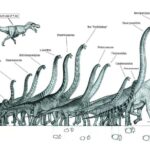Long-necked dinosaurs are among the most iconic and awe-inspiring creatures to ever roam the Earth. Their towering necks, sometimes stretching over 30 feet, have made them the subject of fascination for paleontologists and dinosaur enthusiasts alike. These remarkable creatures are members of a group called sauropods, a category of herbivorous dinosaurs that lived during the Mesozoic Era, approximately 230 to 65 million years ago. But what makes these long-necked dinosaurs so unique, and why did their necks evolve to such extraordinary lengths? Let’s explore the features, types, and significance of long-necked dinosaurs.
Defining Features of Long-Necked Dinosaurs
Long-necked dinosaurs are characterized by their incredibly extended necks, which were made up of numerous vertebrae. These necks could be longer than the entire body of many other dinosaurs, reaching lengths of up to 50 feet in some species. Unlike most other dinosaurs, which had relatively short necks, these sauropods had up to 15 or more vertebrae in their necks—far more than most land animals.
Aside from their necks, long-necked dinosaurs shared other key features:
- Large Bodies: Sauropods were generally massive, with some species weighing over 100 tons.
- Small Heads: Compared to their enormous bodies, their heads were relatively small, often only about the size of a car.
- Long Tails: These dinosaurs also possessed long tails, which balanced out the length of their necks.
- Column-Like Legs: Their legs were thick and pillar-like, designed to support their immense weight.
The long necks of these dinosaurs were not just for show. They played a vital role in helping these herbivores access a variety of vegetation from treetops and other plant life that other animals could not reach.
Why Did Long-Necked Dinosaurs Have Such Long Necks?
The evolution of long necks in sauropods has intrigued scientists for years, and several theories attempt to explain this adaptation:
- Feeding Advantage: The most widely accepted theory is that long necks allowed sauropods to reach vegetation high in trees that other herbivores couldn’t access. This feeding advantage would have given them access to a larger and more diverse food supply, especially in environments where food was scarce at ground level.
- Foraging Efficiency: Having long necks might have allowed these dinosaurs to cover vast areas in search of food without needing to move their massive bodies as much. This would have saved energy and allowed them to graze in a way that other creatures, who had to walk to different locations for food, could not.
- Mating Displays: Some paleontologists suggest that long necks could have been used for display purposes, either to attract mates or to assert dominance over other members of their species. Just as some modern animals use large antlers or brightly colored feathers for such purposes, a long neck could have served as an impressive physical feature for social interactions.
- Thermoregulation: There is also the possibility that long necks helped regulate body temperature. Larger bodies with smaller extremities are better at conserving heat, and a long neck might have assisted in distributing heat more evenly across the body.
Famous Long-Necked Dinosaurs
Several species of dinosaurs are famous for their long necks, with some of the most well-known being:
- Brachiosaurus: This massive sauropod is one of the most recognizable long-necked dinosaurs, distinguished by its relatively shorter tail and upward-sloping neck. Unlike many other sauropods, the Brachiosaurus’ neck was positioned in a way that allowed it to reach tall trees and vegetation. It lived during the late Jurassic period and could grow up to 80 feet long.
- Apatosaurus: Known for its long, whip-like tail and long neck, the Apatosaurus was a large herbivore from the Jurassic period. It was one of the first dinosaurs described in the scientific literature, though it was once mistakenly thought to be the same as the Brontosaurus.
- Diplodocus: Another well-known sauropod, the Diplodocus had an incredibly long neck and tail, making it one of the longest dinosaurs ever discovered. It was more slender than some other sauropods, and scientists believe it may have used its long neck to graze on low-lying plants in addition to taller trees.
- Argentinosaurus: One of the largest known dinosaurs, Argentinosaurus was a massive sauropod that lived during the Cretaceous period. It had a long neck, but what truly set it apart was its overall size—measuring over 100 feet in length and weighing up to 100 tons.
Life and Behavior of Long-Necked Dinosaurs
While we know a great deal about the physical attributes of long-necked dinosaurs, much of their behavior remains a mystery. It is believed that these giants traveled in herds for protection against predators, as their immense size would have made them less vulnerable to attack. Their diet mostly consisted of plant material, ranging from ferns to conifers, depending on the species.
The long necks likely helped them to browse large areas of vegetation in search of food, but the specifics of their feeding behaviors are still being studied. Evidence suggests that some species of long-necked dinosaurs may have used their necks to sweep entire sections of plants into their mouths in one go, while others might have moved slowly from one tree to the next.
The Extinction of Long-Necked Dinosaurs
The long-necked dinosaurs, along with many other dinosaurs, met their extinction around 65 million years ago at the end of the Cretaceous period. The causes of this mass extinction are still debated, but the most commonly accepted explanation is the impact of a massive asteroid, along with volcanic activity and climate changes, which disrupted ecosystems and food sources.
Despite their extinction, long-necked dinosaurs remain a symbol of the vast and varied life forms that once dominated the Earth. Their legacy is alive today through their fossilized remains, which continue to provide valuable insights into prehistoric life.

Conclusion
Long-necked dinosaurs, particularly the sauropods, were some of the most fascinating creatures to ever walk the Earth. Their towering necks, enormous bodies, and herbivorous lifestyles set them apart from other dinosaurs. These incredible adaptations allowed them to thrive for millions of years, feeding on plants in ways that were inaccessible to other herbivores. Though they are no longer with us, the study of long-necked dinosaurs helps us understand more about the natural world that existed long before humans, reminding us of the extraordinary diversity of life that once flourished on our planet.



